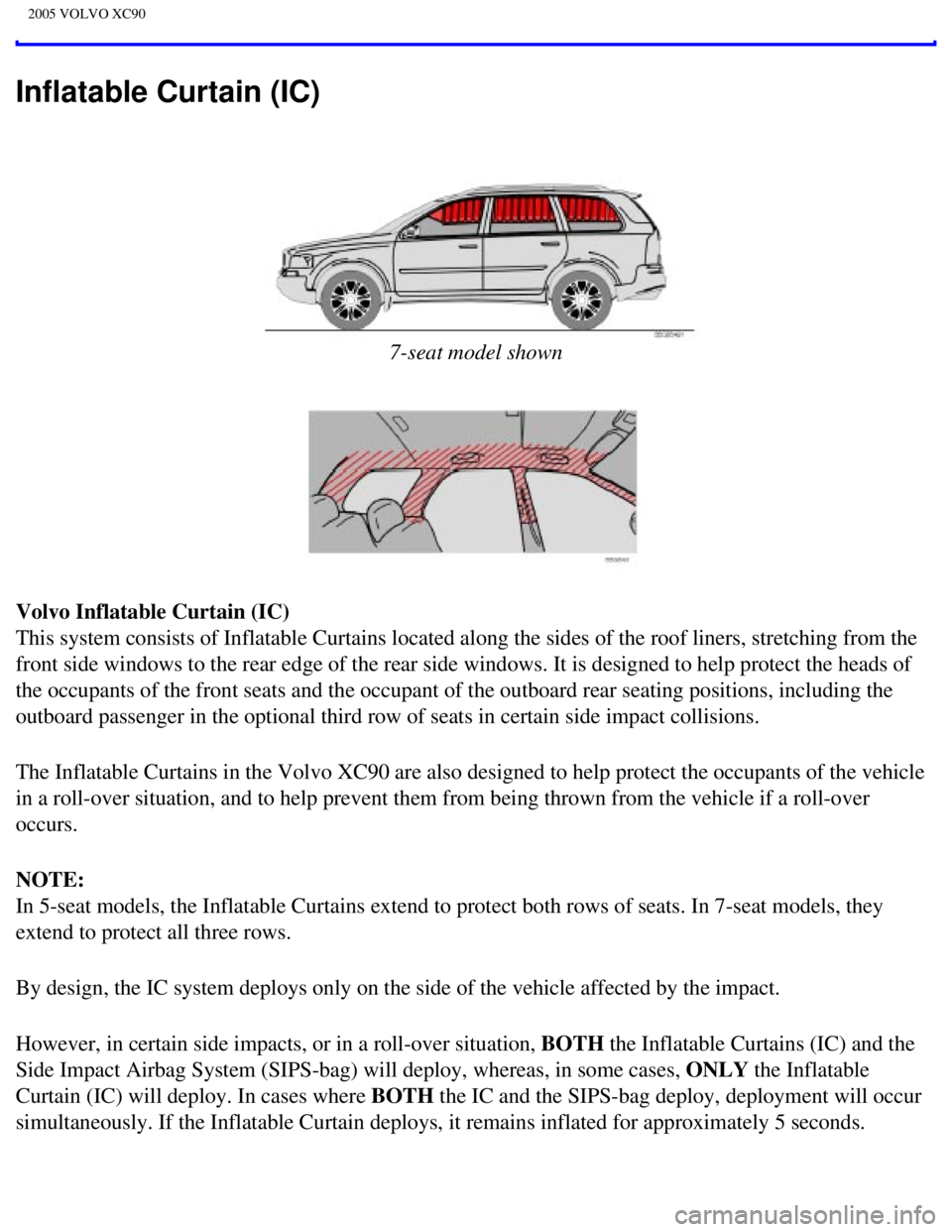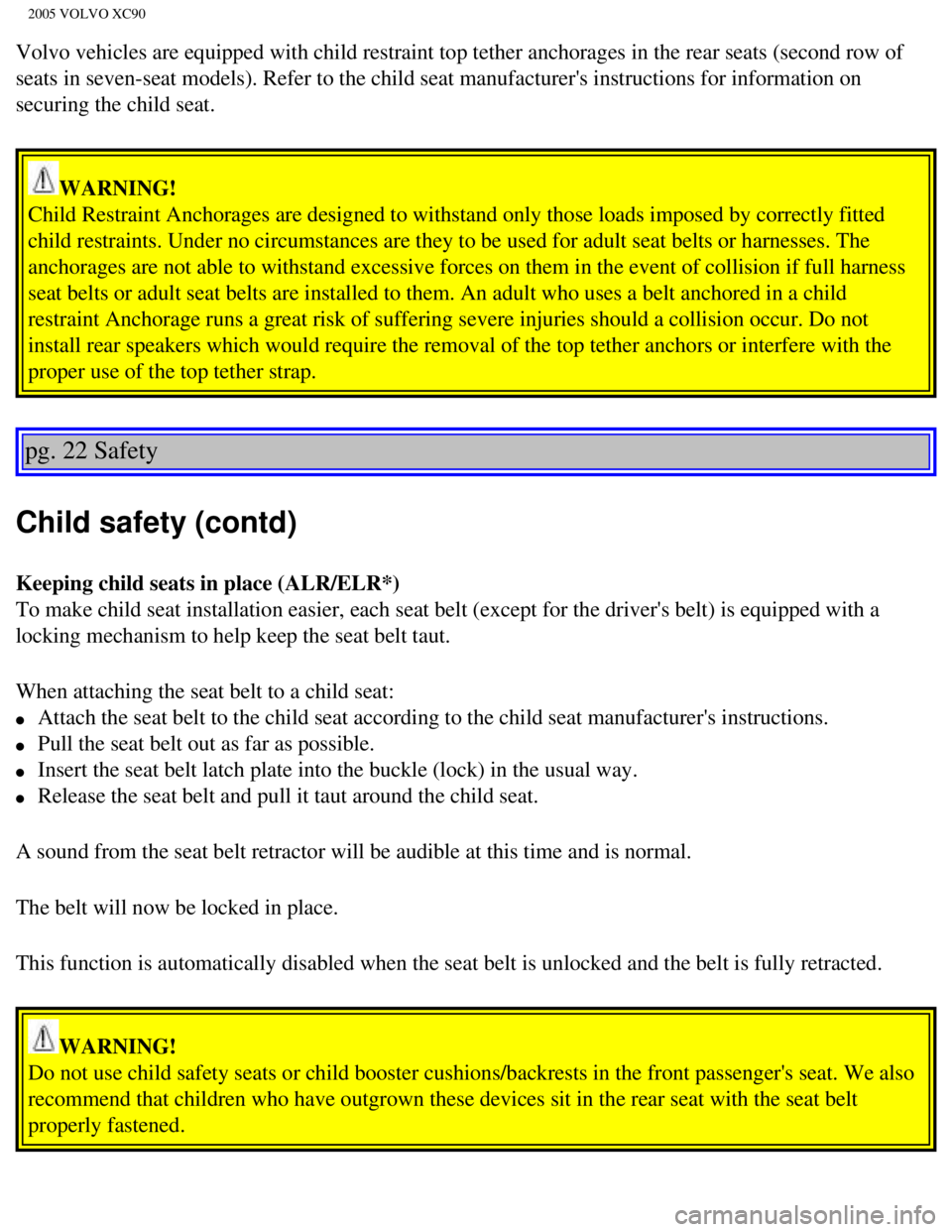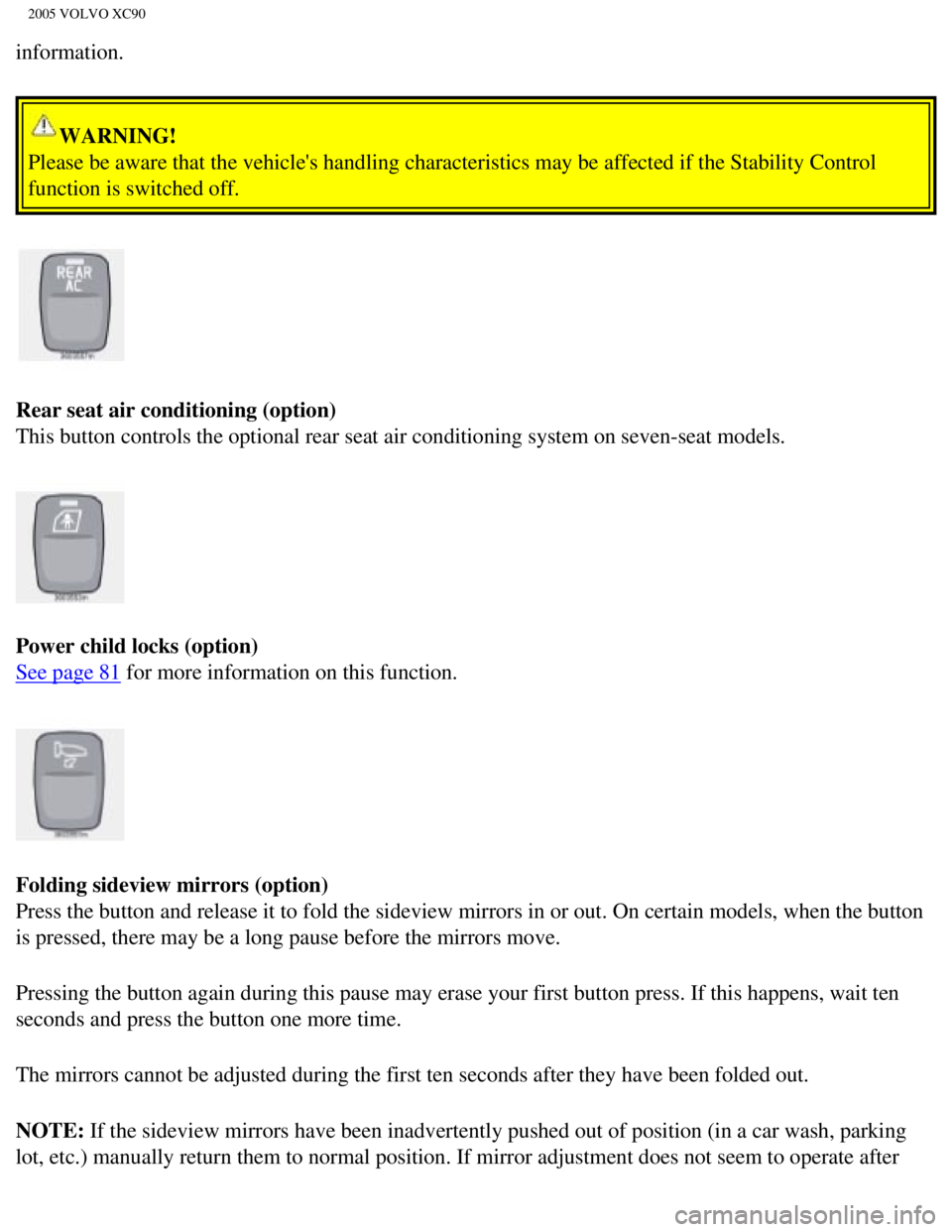2005 VOLVO XC90 ECO mode
[x] Cancel search: ECO modePage 4 of 263

2005 VOLVO XC90
environmental impact of a product throughout its complete life cycle. In\
this context, design, production,
product use, and recycling are all important considerations.
In production, Volvo has partly or completely phased out several chemica\
ls including chlorofluorocarbons
(CFCs), lead chromates, naphtanates, asbestos, mercury and cadmium; an\
d reduced the amount of chemicals
used in our plants 50% since 1991.
Volvo was the first in the world to introduce into production a three-wa\
y catalytic converter with Lambda
Sond, now called oxygen sensor, in 1976. The current version of this hig\
hly efficient system reduces emissions
of harmful substances (CO, HC, NOx) from the exhaust pipe by approxima\
tely 95% and the search to eliminate
the remaining emissions continues. Volvo is the only automobile manufact\
urer to offer CFC-free retrofit kits
for the air conditioning system of all models as far back as the 1975 Vo\
lvo 240. Advanced electronic engine
controls, refined purification systems and cleaner fuels are bringing us\
closer to our goal.
After Volvo vehicles and parts have fulfilled their use, recycling is th\
e next critical step in completing the life
cycle. The metal content is about 75% of the total weight of a vehicle, \
which makes the vehicle among the most
recycled industrial products. In order to have efficient and well contro\
lled recycling, many Volvo variants have
printed dismantling manuals, indicating the weight and material of indiv\
idual components. For Volvo, all
homogeneous plastic parts weighing more than 1.7 oz. (50 grams) are ma\
rked with international symbols that
indicate how the component is to be sorted for recycling.
In addition to continuous environmental refinement of conventional gasol\
ine-powered internal combustion
engines, Volvo is actively looking at advanced technology alternative-fu\
el vehicles.
When you drive a Volvo, you become our partner in the work to lessen the\
vehicle's impact on the environment.
To reduce your vehicle's environmental impact, you can:
l Maintain proper air pressure in your tires. Tests have shown decreased f\
uel economy with improperly
inflated tires.
l Follow the recommended maintenance schedule in your Warranty and Service\
Records Information booklet.
l Drive at a constant speed.
l See an authorized Volvo retailer as soon as possible for inspection if t\
he check engine (malfunction
indicator) lamp illuminates, or stays on after the vehicle has started.\
l Properly dispose of any vehicle-related waste such as used motor oil, us\
ed batteries, brake pads, etc.
l When cleaning your vehicle, use Volvo's own vehicle care products, all o\
f which have systematically been
adapted to the environment.
For additional information regarding the environmental activities in whi\
ch Volvo Cars of North America, LLC
and Volvo Car Corporation are involved, visit our Internet home page at:\
http://www.volvocars.us
PremAir®
On the surface of the radiator in the engine compartment, there is a spe\
cial coating called PremAir®. PremAir®
file:///K|/ownersdocs/2005/2005_XC90/05xc90_00.htm (4 of 7)12/30/2006 \
4:42:22 PM
Page 25 of 263

2005 VOLVO XC90
Inflatable Curtain (IC)
7-seat model shown
Volvo Inflatable Curtain (IC)
This system consists of Inflatable Curtains located along the sides of t\
he roof liners, stretching from the
front side windows to the rear edge of the rear side windows. It is desi\
gned to help protect the heads of
the occupants of the front seats and the occupant of the outboard rear s\
eating positions, including the
outboard passenger in the optional third row of seats in certain side im\
pact collisions.
The Inflatable Curtains in the Volvo XC90 are also designed to help prot\
ect the occupants of the vehicle
in a roll-over situation, and to help prevent them from being thrown fro\
m the vehicle if a roll-over
occurs.
NOTE:
In 5-seat models, the Inflatable Curtains extend to protect both rows of\
seats. In 7-seat models, they
extend to protect all three rows.
By design, the IC system deploys only on the side of the vehicle affecte\
d by the impact.
However, in certain side impacts, or in a roll-over situation, BOTH the Inflatable Curtains (IC) and the
Side Impact Airbag System (SIPS-bag) will deploy, whereas, in some cas\
es, ONLY the Inflatable
Curtain (IC) will deploy. In cases where BOTH the IC and the SIPS-bag deploy, deployment will occur
simultaneously. If the Inflatable Curtain deploys, it remains inflated f\
or approximately 5 seconds.
file:///K|/ownersdocs/2005/2005_XC90/05xc90_01b.htm (3 of 16)12/30/200\
6 4:42:25 PM
Page 35 of 263

2005 VOLVO XC90
Volvo vehicles are equipped with child restraint top tether anchorages i\
n the rear seats (second row of
seats in seven-seat models). Refer to the child seat manufacturer's ins\
tructions for information on
securing the child seat.
WARNING!
Child Restraint Anchorages are designed to withstand only those loads im\
posed by correctly fitted
child restraints. Under no circumstances are they to be used for adult s\
eat belts or harnesses. The
anchorages are not able to withstand excessive forces on them in the eve\
nt of collision if full harness
seat belts or adult seat belts are installed to them. An adult who uses \
a belt anchored in a child
restraint Anchorage runs a great risk of suffering severe injuries shoul\
d a collision occur. Do not
install rear speakers which would require the removal of the top tether \
anchors or interfere with the
proper use of the top tether strap.
pg. 22 Safety
Child safety (contd)
Keeping child seats in place (ALR/ELR*)
To make child seat installation easier, each seat belt (except for the \
driver's belt) is equipped with a
locking mechanism to help keep the seat belt taut.
When attaching the seat belt to a child seat:
l Attach the seat belt to the child seat according to the child seat manuf\
acturer's instructions.
l Pull the seat belt out as far as possible.
l Insert the seat belt latch plate into the buckle (lock) in the usual w\
ay.
l Release the seat belt and pull it taut around the child seat.
A sound from the seat belt retractor will be audible at this time and is\
normal.
The belt will now be locked in place.
This function is automatically disabled when the seat belt is unlocked a\
nd the belt is fully retracted.
WARNING!
Do not use child safety seats or child booster cushions/backrests in the\
front passenger's seat. We also
recommend that children who have outgrown these devices sit in the rear \
seat with the seat belt
properly fastened.
file:///K|/ownersdocs/2005/2005_XC90/05xc90_01b.htm (13 of 16)12/30/20\
06 4:42:25 PM
Page 41 of 263

2005 VOLVO XC90
continuously with the needle in the red area of the dial, which indicate\
s maximum allowable engine rpm
range. Instead, shift to a higher gear or slow the vehicle down. The eng\
ine management system will
automatically prevent excessively high engines speeds. This will be noti\
ceable as a pronounced
unevenness in engine speed.
10. Gear and driving mode indicator
The currently selected driving mode is displayed here. If you use the op\
tional Geartronic function on the
automatic transmission, the currently selected gear will be displayed.
11. Ambient temperature gauge
This display indicates the air temperature outside your vehicle. A "snow\
flake" symbol in the text
window is displayed when the temperature is in the range of 23 - 36° \
F (-5 - +2° C). Please note that this
symbol does not indicate a fault with your vehicle. At low speeds or whe\
n the vehicle is not moving, the
temperature readings may be slightly higher than the actual ambient temp\
erature.
12. Clock/set button
Turn the button to set the clock.
13. Fuel gauge
The fuel tank holds approximately:
Models with 6-cylinder turbo engines - 19 US gallons (72 liters).
Models with 5-cylinder turbo engines - 18 US gallons (68 liters).
When a warning light in the gauge comes on, there are approximately 1.8 \
US gal. (8 liters) of fuel
remaining in the tank.
14. Indicator and warning symbols
pg. 27 Instruments and controls
Indicator and warning symbols
The indicator and warning symbols light up when you turn the ignition ke\
y to the driving position
(position II) before starting. This shows that the symbols are functio\
ning. When the engine starts, all
symbols go out. If the engine is not started within 5 seconds, all symbo\
ls except CHECK ENGINE and
go out. The symbol for the parking brake goes out when the parking brak\
e is released.
Warning symbol
in center of instrument panel
This symbol shines as a red or yellow light depending on the severity of\
the fault that has been detected.
Red symbol -Stop the vehicle as soon as possible in a suitable location and read th\
e message shown in
file:///K|/ownersdocs/2005/2005_XC90/05xc90_02a.htm (3 of 17)12/30/200\
6 4:42:27 PM
Page 47 of 263

2005 VOLVO XC90
information.
WARNING!
Please be aware that the vehicle's handling characteristics may be affec\
ted if the Stability Control
function is switched off.
Rear seat air conditioning (option)
This button controls the optional rear seat air conditioning system on s\
even-seat models.
Power child locks (option)
See page 81 for more information on this function.
Folding sideview mirrors (option)
Press the button and release it to fold the sideview mirrors in or out. \
On certain models, when the button
is pressed, there may be a long pause before the mirrors move.
Pressing the button again during this pause may erase your first button \
press. If this happens, wait ten
seconds and press the button one more time.
The mirrors cannot be adjusted during the first ten seconds after they h\
ave been folded out.
NOTE: If the sideview mirrors have been inadvertently pushed out of position \
(in a car wash, parking
lot, etc.) manually return them to normal position. If mirror adjustmen\
t does not seem to operate after
file:///K|/ownersdocs/2005/2005_XC90/05xc90_02a.htm (9 of 17)12/30/200\
6 4:42:27 PM
Page 49 of 263

2005 VOLVO XC90
12 volt socket
This 12 volt socket can be used to plug in certain accessories such as c\
ellular telephones, etc. The
ignition key must be in position 1 (or higher) for the auxiliary socke\
t to function.
NOTE: The auxiliary sockets can also be used for cigarette lighters, which ar\
e available as accessories
at your Volvo retailer.
pg. 33 Instruments and controls
Lighting panel
A - Headlights and parking lights
All lighting off.
Models with daytime running lights:
Low beam headlights will automatically come on if the ignition key is in\
position II. Front and rear
parking lights, tail lights, side marker lights, and license plate light\
s will also be on. Volvo recommends
the use of daytime running lights. If, however, you would prefer to have\
these lights turned off (USA
only), please consult your Volvo retailer. Please note that the use of \
daytime running lights is mandatory
in Canada.
NOTE: Bi-Xenon headlights (option): Turn the headlight switch to position 0\
to activate a daylight
sensor, which automatically switches the low beams on or off, depending \
on ambient light conditions.
When driving in daylight, the headlights will switch off and the daytime\
running lights will come on. In
darkness, the daytime running lights will switch off and the Bi-Xenon he\
adlights will switch on.
Parking lights on. The parking lights should be switched off when you leave the vehicle to \
help avoid battery drain.
Headlights, parking lights, license plate lights and instrument panel il\
lumination are on if the
ignition key is in position II.
The headlight switch must be in this position before the high beams will\
function (this also applies on
file:///K|/ownersdocs/2005/2005_XC90/05xc90_02a.htm (11 of 17)12/30/20\
06 4:42:27 PM
Page 58 of 263

2005 VOLVO XC90
A timer automatically switches off the heating to the sideview mirrors a\
fter approximately 4 minutes and
to the rear window after approximately 12 minutes. The LED will go out c\
orrespondingly.
Heated front seats (option)
l The front seat heating can be switched on and off as required.
l Press the switch once for maximum seat heating. Both LED's in the switch\
will be lit.
l Press the switch a second time for comfort heating. One LED in the switc\
h will be lit.
l Press the switch a third time to turn the heating off completely.
The seat heating for the passenger seat should be switched off when the \
seat is not occupied.
pg. 39 Instruments and controls
Trip computer (option)
The trip computer stores information gathered from several systems in yo\
ur vehicle and has four menus
that can be displayed in the text window.
l Driving distance on current fuel reserve
l Average fuel consumption
l Current fuel consumption
l Average speed
l Current speed in mph (Canadian models only)
NOTE: Warning messages from the vehicle's monitoring systems will override the\
trip computer
function. If a warning message is displayed in the text window while you\
are using the trip computer,
file:///K|/ownersdocs/2005/2005_XC90/05xc90_02b.htm (3 of 17)12/30/200\
6 4:42:28 PM
Page 59 of 263

2005 VOLVO XC90
you must acknowledge the message by pressing button A. Press button A ag\
ain to return to the trip
computer function.
Trip computer controls and functions.
The four* trip computer functions can be accessed by twisting control B \
one step at a time in either
direction. Twisting a fifth** time returns you to the original function.\
The trip computer can be reset (current data will be erased from system\
memory) by pressing RESET
(button C).
1. Driving distance on current fuel reserve
This function shows the approximate distance that can be driven on the f\
uel remaining in the tank. This
calculation is based on average fuel consumption during the last 12 mile\
s (20 km) of driving and the
amount of fuel remaining in the tank when the reading was taken.
When the driving distance on current fuel reserve is less than 12 miles \
(20 km), "----" will be displayed
in the text window.
2. Average fuel consumption
This value indicates fuel consumption since the last time the trip compu\
ter was reset (by pressing
RESET, button C). When the engine is switched off, information on fuel \
consumption is stored and
remains in system memory until the RESET (button C) is pressed again.
3. Current fuel consumption
This value indicates the current fuel consumption, based on readings tak\
en once per second. When the
vehicle is not moving, "----" will be displayed.
4. Average speed
This value indicates average speed since the last time the trip computer\
was reset (by pressing RESET,
button C). When the engine is switched off, information on average spee\
d is stored and remains in
system memory until the RESET (button C) is pressed again.
5. Current speed in miles per hour (Canadian models only)
This function provides the driver with an instantaneous conversion of th\
e vehicle's current speed from
km/h to mph.
NOTE: Trip computer readings may vary slightly depending on the circumference\
of the tires on the
vehicle.
* Five functions on Canadian models
** A sixth time on Canadian models
file:///K|/ownersdocs/2005/2005_XC90/05xc90_02b.htm (4 of 17)12/30/200\
6 4:42:28 PM